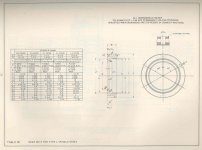As the owner of a LeBlond 13" x 42" Roundhead" Regal lathe blt in 1943, I can speak from experience. Your photo shows the threaded spindle nose. On a 15" "Roundhead" Regal lathe, this would be 2 1/8"-5 . I believe the "Roundhead" Regal lathes first were offered with the threaded spindle nose as standard, and the long-taper spindle nose as an option. Sometime after WWII, LeBlond turned the tables on this, and the long-taper spindle nose was the standard and the threaded spindle nose was optional.
Customers who already owned LeBlond lathes with this threaded spindle nose could (and often did) opt for the threaded spindle noses on lathes purchased after the long-taper spindle nose was the standard.
There is no set standard for threaded lathe spindle noses. Each manufacturer did what they felt was a sound design for the lathes they were building. 2 1/4" threaded spindle noses were common between Southbend and Logan and probably a few other makers. LeBlond, for whatever reason, went with the 2 1/8" spindle nose diameter x 5 threads/inch.
We are on our own to make backplates to fit these threaded spindle noses. You will not find a threaded backplate for the 2 1/8"-5 threaded spindle nose 'off the shelf'.
As Thermite notes, most lathe chucks are built with a 'plain back'. A "plain back" has no means of mating or connecting the chuck to a spindle. Rather, it is a back having a counterbore or recess machined in it. To mount a plain back chuck, the backing plate is setup on the spindle of the lathe it is to be run on (ideally). The backplate is then machined with what is known as a 'spigot', or raised section that snugly fits into the recess on the back of the chuck body. This holds the chuck concentric with the spindle, and also gives the necessary rigidity rather than relying solely on the mounting screws.
To remove the backing plate from the spindle of a lathe with a threaded spindle nose, it simply unscrews. I am likely off base in using the word "simply", because threaded chuck backplates occasionally are screwed on tightly to the point of being locked onto the spindle. To remove the backplate from the spindle of a Roundhead Regal lathe, put the lathe in its lowest speed. Since there are bolts in the chuck plate, make them up so they are solidly in the chuckplate with shanks projecting out from the mounting face of the chuckplate. Using longer bolts with nuts screwed into the chuck plate and making them up with nuts to further lock them into the chuckplate is what I'd suggest. Take a length of bar stock or a short prybar, something not more than maybe 30" long. Span two of the bolts sticking out of the backing plate and pull down on the bar. The backing plate may "break loose" and unscrew from the spindle nose. If it is stubborn, caution is needed as the gears in the headstocks of the Roundhead Regal lathes are notorious for being on the light side and easily damaged. If the backplate is being stubborn about breaking loose on the spindle nose, take something like a 2 or 3 lb dead blow hammer as a persuader. Pull down on the bar with one hand, holding a good strain on the bar, and give the bar a smack or two with the dead blow hammer. Place the hammer blows about 12" out from the centerline of the spindle and do not get too wild or vindictive with the hammer.
This method usually will break loose a chuck plate on a screwed spindle nose. LeBlond, in using the very coarse thread, did us a favor as this design seems to be less prone to having chuck plates lock up hard on the spindle noses. The spindle nose threaded length is not long in proportion to its diameter. The odd thing in the photos is the shoulder on the spindle is not visible. The threaded spindle noses have a shoulder which the chuckplates (or faceplates) screw hard against when made up on the spindle. I wonder if whomever made the chuckplate in the OP's photos did something crazy like machining a counterbore in the hub of the chuck plate to go over the shoulder/collar on the spindle nose.
BTW:, the spindle nose thread is a right hand thread, so unscrews counterclockwise when facing the spindle nose. On my own Roundhead Regal lathe, I usually have to use a short lever of some sort, either a short bar thru the chuck jaws or a 15" adjustable wrench on one jaw to break things loose. One good yank (no hammer needed) and the chuck or faceplate breaks loose for me. I keep the spindle threads clean and put a dab of 'Never Seez' on them and the spindle 'register' (unthreaded area and the face of the collar or shoulder) before making up a chuck or faceplate. A little care in cleaning the threads on both the spindle and whatever is going onto it is key.
Two other points: do not run a chuck or faceplate on by spinning it fast so it seats with a slam, nor starting the lathe with the chuck or faceplate not entirely made up hard on the spindle. These Regal lathes are good light duty lathes, but the gears in the headstock have to be babied. Trying to unstick a stuck chuck and getting too rammy can destroy teeth in the headstock, and then it's FUBAR for all practical purposes.


